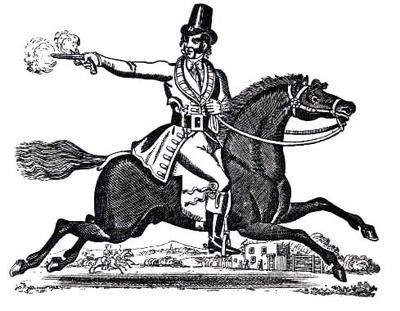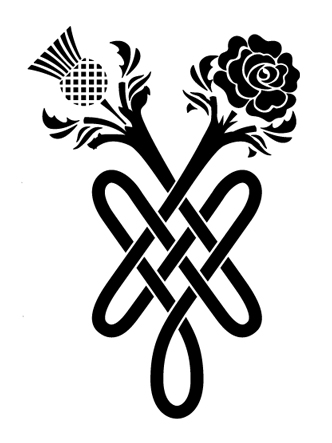
Richard Turpin was born in 1705 in the Blue Bell Inn, Hempstead, the son of John Turpin, whose trades included butchery, farming and inn-keeping, and Mary Elizabeth Parmenter. Dick was the fifth out of their six children and, as a young man, he completed an apprenticeship as a butcher, in the Whitechapel area of London. He set up in business for himself in Essex. Sources claim that his father had links with smuggling and it is possible that young Dick spent his childhood in immersed in crime.
Once established as a butcher, Turpin forged a relationship with a local gang, alternatively known as the Gregory Gang and the Essex Gang, who specialised in poaching deer and other livestock theft. Through this means, he was able to supplement his legitimate butchery business. There are unsubstantiated claims that Turpin married Elizabeth Millington in 1725.
At some point, around 1734, Turpin abandoned his butcher's business in favour of his more profitable criminal activities, and set up as an inn-keeper. Towards the end of that year, the gang had progressed to burglary, mainly of local farms. It has never been proved that Turpin played an active role in these robberies.
By the end of January 1735, Turpin was known to be involved in house theft after turning up at the home of a Mr Sheldon, masked and armed with four members of the gang. Further robberies, each increasingly violent, occurred within the space of a few weeks. During one such crime, the house-holder was stripped of his lower clothing and had his buttocks burned over the fire, while a maid-servant was raped. This robbery netted the gang £30 and led to the Duke of Newcastle offering a reward of £50 for any information leading to their capture.
Some members of the gang were captured. One was shot and died later in prison, others were tried, convicted and hung as a result of the evidence laid against them by gang member John Wheeler. Wheeler was released after betraying the rest of the gang and died in 1738, in Hackney. No cause of death was recorded, although rumour suggested that his death was the result of retaliation by Turpin.
Following the loss of his gang, Turpin appeared to lie low for a while. In May 1737, he was involved in two fatal shootings within a matter of days. Thomas Morris, a game-keeper, was shot in cold blood after confronting Turpin in Epping Forest. Matthew or Tom King (sources vary), Turpin’s new accomplice, was killed in an attempted capture. While the evidence over who caused King’s death is debatable, the bullet was fired either by Turpin or Richard Bayes, landlord of the inn where the shooting occurred. Bayes's original statement implicated Turpin in King's murder but was later amended. It was generally accepted at the time that King’s death was accidental.
Following the death of King, Turpin changed his name to John Palmer and moved to Yorkshire. After several crime free months, Turpin was caught up in a minor incident when he shot the cockerel of a John Robinson, in the street. In the following argument, John Palmer threatened to shoot Robinson too. The constabulary were called and Palmer was escorted to Beverly House of Correction. He was later transferred to York Castle, after it was suspected Palmer was living off illegal earnings. A letter he wrote to his brother, for which his brother refused to pay the postage, was opened by a judge. The hand-writing identified by his former teacher, James Smith. It was clear that Palmer was none other than Dick Turpin.
On March 22nd 1739, Turpin appeared at York Assizes charged with 3 charges of horse theft. Turpin had no formal defence and claimed that he had not known where or when the trial was to take place, therefore he had been unable to prepare his defence or produce witnesses. Nevertheless, the judge found Turpin guilty and sentenced him to death.
On April 7th, dressed in a new jacket and shoes and escorted by a group of five hired mourners, Turpin was taken to Knavesmire, where he gave an overly long speech. The executioner finally cut this short. Turpin threw himself from the scaffold, depriving the executioner of his moment of glory. After five minutes on a short drop rope, Turpin died of suffocation. Following confirmation of his death, Turpin’s remains were taken away and interred, allegedly in St George’s churchyard, Fishergate. Since he had been convicted on charges of horse theft but not that of highway robbery, Turpin was spared the usual post-mortem practice of his remains being displayed either in chains or gibbet around the city.
As time has passed, the legend of notorious highwayman, Dick Turpin has seen him grow into something of an eighteenth century Robin Hood. While there may have been occasions where he robbed travellers, his main focus seems to have been poaching, theft of animals, and burglary with violence. The legendary 200 mile ride from London to York that caused the death of his beloved horse Black Bess, appears to be entirely fictional. It may be based on a similar story in which 17th century highwayman John “Swift Nick” Nevison rode through the day from London to York, in order to provide himself with an unshakable alibi after committing a robbery. He made his way to a bowling green and engaged the Mayor in conversation, placing a bet on the outcome of the match. When subsequently arrested for the crime, he produced the mayor as his witness. The judge agreed there was no possibility of a man being able to cover the journey in 16 hours on a horse and Nevison was released.












 RSS Feed
RSS Feed